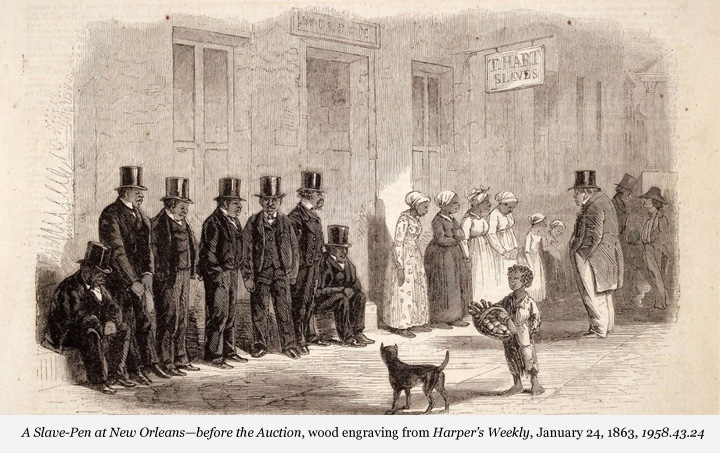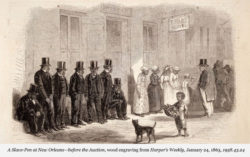Spring 2015
When Humans Were Chattel
The Purchased Lives exhibition surveys the brutal business of the domestic slave trade and one of its biggest hubs, New Orleans
Published: June 2, 2015
Last Updated: February 1, 2019

Courtesy of The Historic New Orleans Collection
A slave-pen at New Orleans–before the Auction, wood engraving from Harper's Weekly, January 24, 1863.
The importation of slaves to Virginia and neighboring Maryland and North Carolina had slowed in the years following the American Revolution, due in large part to a steep decline in tobacco markets. This decline precipitated widespread changes to the local economy. As planters shifted production from the labor-intensive and soil-exhausting cultivation of tobacco to wheat, they found themselves with an excess of enslaved laborers. At the same time, Eli Whitney’s 1793 invention of the cotton gin, a machine that allowed processers to easily and efficiently separate cotton from its seeds, encouraged the expansion of American agricultural lands beyond the Mississippi River. The Louisiana Purchase (1803) and the cession and seizure of American Indian lands in Florida, Mississippi, Alabama, Tennessee, and Georgia in later decades significantly increased the number of acres available for agricultural production.
In the half century following America’s 1808 abolition of the international slave trade, growing demands for laborers triggered the forced migration of an estimated one million people. As the volume of individuals being sent South increased, so too did the efficiency of slave-trading firms, such as Virginia-based Franklin, Armfield, and Ballard, which systematized the process of shipping large numbers of slaves from one port to another via coastal vessels. The domestic slave trade wreaked havoc on the lives of enslaved families and communities as owners and traders in the Upper South—Maryland, North Carolina, Virginia, and Washington, DC—oversaw the shipment and sale of surplus laborers to the expanding territory of the Lower South—Alabama, Florida, Louisiana, Mississippi, and Texas—often breaking up families in the process.
Purchased Lives: New Orleans and the Domestic Slave Trade, 1808–1865, on view at The Historic New Orleans Collection through July 18, examines the lives of those caught up in the trade and considers New Orleans’s role as antebellum America’s largest slave market. Period broadsides, paintings, and prints illustrate how the domestic slave trade appeared in the public sphere, while manuscript, cartographic, photographic, and three-dimensional objects—including ships’ manifests, slave clothing, a patient admission book from Touro Infirmary, and a diary from John Pamplin Waddill (the Louisiana lawyer who helped free Solomon Northup)—speak to the experiences of those whose lives were bought and sold. First-person accounts excerpted from published and unpublished slave narratives and oral histories are included throughout the exhibition.
Purchased Lives consists of more than 85 objects from The Collection’s holdings as well as artifacts on loan from Belmont Mansion, Evergreen Plantation, Louisiana State Museum, Midlo Center for New Orleans Studies at the University of New Orleans, National Archives and Records Administration, New Orleans Notarial Archives, Touro Infirmary Archives, and private collections.
Editor’s Note: This article originally appeared in the spring 2015 issue of The Historic New Orleans Collection Quarterly and references an exhibit that is no longer on view. For current exhibits at the Historic New Orleans Collection, please visit www.hnoc.org.
Eve Abrams of WWNO 89.9, New Orleans’ NPR affiliate, interviewed Erin Greenwald, curator of “Purchased Lives,” an exhibition examining the domestic slave trade on view at the Williams Research Center of The Historic New Orleans Collection (410 Chartres Street) through July 18. Listen to the radio program at this link.

